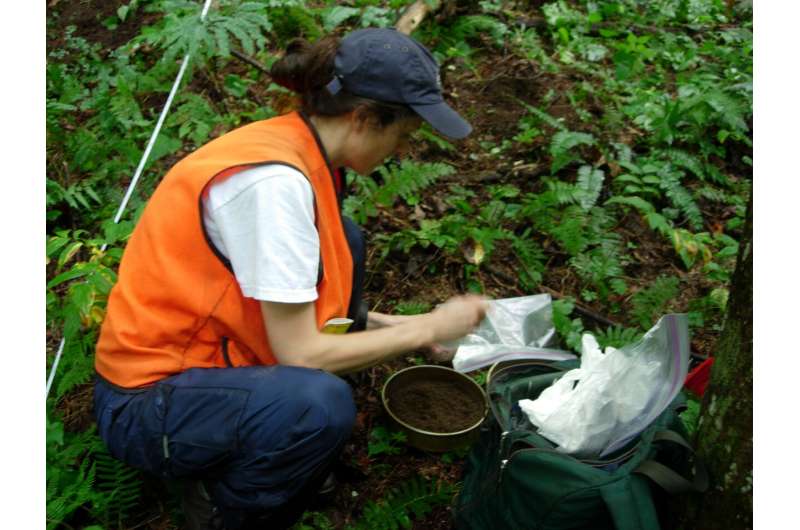This article has been reviewed according to Science X's editorial process and policies. Editors have highlighted the following attributes while ensuring the content's credibility:
fact-checked
trusted source
proofread
Soil carbon, nitrogen, soil fertility and climate change are tightly linked, new research shows

In a first-of-its-kind long-term study, a collaborative group of scientists, including senior author Ashley Keiser, assistant professor of soil ecology at the University Of Massachusetts Amherst's Stockbridge School of Agriculture, have discovered that soil carbon determines whether mineralized nitrogen is available in the soil as ammonium, or further transformed into either nitrates that are easily lost to runoff and contribute to toxic algal blooms or nitrous oxide, which is 300 times more potent than carbon dioxide at warming the atmosphere.
The research, published recently in Biogeochemistry Letters, additionally shows that the relationship between soil carbon and nitrogen seems to hold across ecosystems, from the tundra to the subtropics.
"All living organisms need nutrients in specific ratios," says Keiser. "Just think of your daily vitamins. If you take too much vitamin C, for example, your body excretes it so that you can stay healthy."
The same holds true for the soil's microbial communities. There are billions of microbes in every teaspoon of soil. They are the predominant form of life on Earth and they depend upon both carbon and nitrogen for their survival. Just like with humans and vitamin C, microbes take the carbon and nitrogen they need into their bodies, and process and transform the rest, eventually passing it back into the soil.
Microbes break down organic matter—think of dead leaves, rotting wood and the uncountable microbe carcasses. This process is called "mineralization," and it pulls the carbon out of the dead matter and makes it available for the microbe to burn as energy.
Microbes also mineralize the nitrogen in that dead matter into ammonium—and plants love ammonium. But microbes can further transform the nitrogen into nitrates, which are easily dissolved in water. When nitrates are abundant in the soil, they can wash into streams and rivers, where they eventually feed vast algal blooms toxic to many aquatic plants and animals. Furthermore, nitrification can also produce nitrous oxide, a far more potent greenhouse gas than carbon dioxide.
What Keiser and her team discovered is that the amount of carbon in the soil drives how microbes process nitrogen.
"When soil carbon stocks are high," says Keiser, "microbes need much more nitrogen for themselves, because, just like us, they need a balanced diet." And while increased microbial nitrogen usage means that less is transformed into nitrates, it also means that there's less ammonium available for nourishing plants.
The opposite holds true, too. When there's less carbon in the soil, microbes pass more of the nitrogen through their systems, turning it into ammonium, nitrates, and, possibly, nitrous oxide.
The key is the carbon, an insight that Keiser and the paper's lead author, Allison Gill, assistant professor of biology at Williams College, discovered with the help of the National Science Foundation's (NSF) Long Term Ecological Research (LTER) Network. "To test our hypotheses, we leveraged databases associated with 14 terrestrial LTER sites across the U.S.," says Gill.
"These sites encompassed diverse ecosystems including tundra, boreal forests, deserts and grasslands. The large dataset, which includes measurements collected over a 40-year period, provided a powerful tool for evaluating how soil carbon concentration interacts with and constrains nitrogen cycling."
"I will readily admit that all my co-authors and I were surprised to see that carbon's role as a 'gatekeeper' holds across such different ecosystems," says Keiser. "We don't see patterns like this in ecology very often."
The discovery of this relationship has implications for everything from agriculture to climate change mitigation solutions that rely on storing carbon in the soil. "Now that we know this link exists," Keiser says, "we can ask new questions that peel back more layers on these fundamental processes which much of Earth's life depends upon."
More information: A. L. Gill et al, Soil carbon availability decouples net nitrogen mineralization and net nitrification across United States Long Term Ecological Research sites, Biogeochemistry (2023). DOI: 10.1007/s10533-022-01011-w
Provided by University of Massachusetts Amherst




















